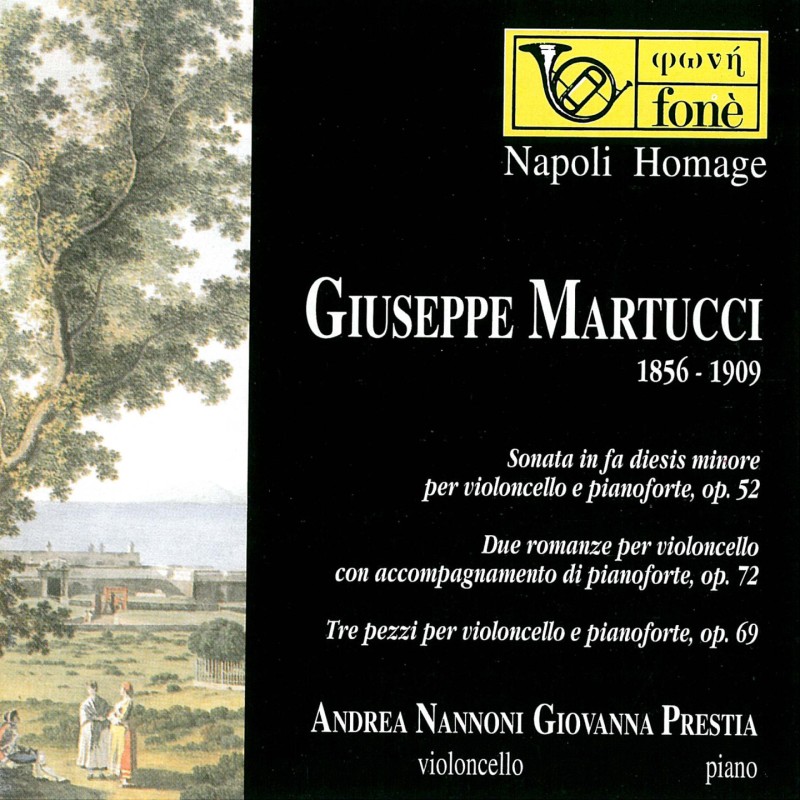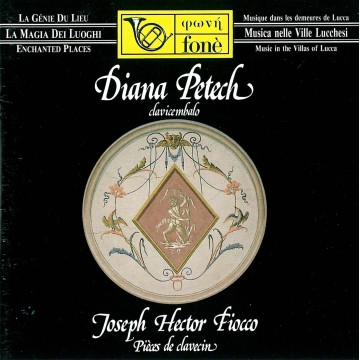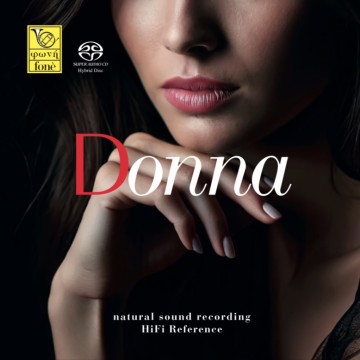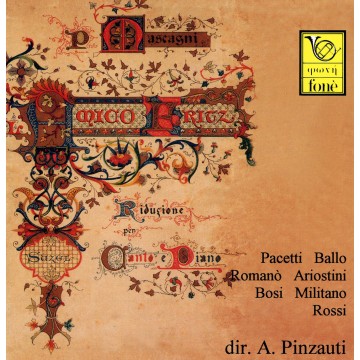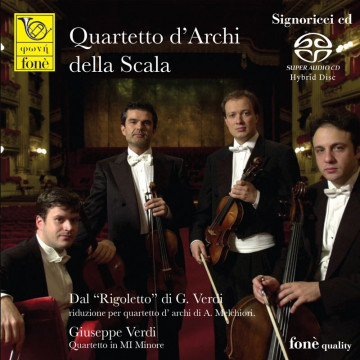G. Martucci (1856 - 1909) - A. Nannoni & G. Prestia (High Resolution Audio)
[Hi-Res Audio] GIUSEPPE MARTUCCI (1856 - 1909)
Andrea Nannoni, violoncello - Giovanna Prestia, pianoforte
TRACKLIST
1. Sonata in fa diesis minore per violoncello e pianoforte, op.52, allegro giusto
2. Sonata in fa diesis minore per violoncello e pianoforte, op.52, scherzo: allegro molto
3. Sonata in fa diesis minore per violoncello e pianoforte, op.52, intermezzo: andantino flebile
4. Sonata in fa diesis minore per violoncello e pianoforte, op.52, finale: allegro
5. Due romanze per violoncello con accompagnamento di pianoforte, op.72, andantino con moto
6. Due romanze per violoncello con accompagnamento di pianoforte, op.72, moderato
7. Tre pezzi per violoncello e pianoforte, op.69, moderato
8. Tre pezzi per violoncello e pianoforte, op.69, andante
9. Tre pezzi per violoncello e pianoforte, op.69, allegro
Total time: 1h 07'
Realizzato e diretto da: Giulio Cesare Ricci
La registrazione è stata effettuata a Fiesole nel luglio 1993 presso la Scuola di Musica di Fiesole.
Maestro delsuono: Giulio Cesare Ricci
Montaggio sonoro: Michele Lippi
La registrazione èstata realizzata con una coppia dimicrofoni Neumann U47 alimentati con AXK completamente stabilizzati.
Il segnale è stato registrato in digitale su DAT Teac R1 tramite Advanced Miko Pre-amplifier.
Per il monitoraggiosono stati usati: Preamplificatore Jeff Rowland Consonance, amplificatoredi potenza Jeff Rowland Model 8Ac, diffusori B&W801 serie III, cavi Power Audioquest Cobalt eSignal Audioquest Lapis.
Giuseppe Martucci (b. Capua 1856, d. Naples 1909). was a child prodigy. He gave his first pianorecital whenhe was eight and then studied at theNaples Conservatoire. From 1870 on, he devoted his life ot teaching and performing. Rubinstein and Liszt both thought very highly of him. Between 1875 and 1880 he played in many European cities, often accompanying the 'cellist Alfredo Patti. Regarded as one of theleading pianists ofhis day, hetaught at the Naples Conservatoire from 1880and was director of the Società del Ouartetto as well as conductor of the Società Sinfonica orchestrawhich had been founded by the Prince of Ardore. During this period he was also active as a composer. He spent the years 1886-1902 in Bologna as director of the Conservatoire and choirmaster at S. Petronio. He did much topromote German music in Italy in particular the works of Wagner. The Italian première of "Tristan" was conducted by him in Bologna ni 1888. Returning to Naples in 1902 as director of the Conservatoirethere, he also became conductor of the Concert Society orchestra which had been re-constituted by Clausetti. Martucci wasone of the most prominent figures on the Italian musical scene during the period in which opera tended to dominate. He madea substantial contribution towards the rebirth of instrumental music in Italy at the turn of the century, channelling hisenergies into performing foreign - and especially German - music. He also helped to found organizations dedicated to this task and, although he was notalone in this field he was certainly the most important figure and gained the respecto fhiscontemporariesfor the ideas which hepersuedso energetically. In his larger compositions - such as the two symphonies and the two piano concertos - Martucci is clearly paying homage to the German tradition. In fact, he often came underfire for his failure to develop a more Italian style. But if he is seen as an heir to the Beethoven- Brahms tradition at a time when there was nothing comparable in Italy, it should be remembered that eh was acting no differently from Haydnor Mozart when they adopted the Italian operatic tradition of their day and made it their own. In the field of chamberand solo piano music, however, Martucci succeeded in creating a style thatwas closerto home;even Liszt pointed out the obvious indebtedness to Domenico Scarlatti. Many of the piano pieces maybe accounted some ofhis best compositions. (Some of these he later orchestrated- ni the case of the NotturnoOp. 76 and the Novelletta Op. 82 with notable success.) They still feature in recital programmes and are studied at Italian conservatoires, although it is not quite clear whycertain pieces have recently tended to disappear from the repertoire.There is an obvious link withthe Italian operatic tradition in t h eMeditations on "Un ballo in maschera" for piano-duet.That such links are rare in Martucci's output is due tohis personal taste rather than to snobbery. nI addition to the largenumber of works for piano, other noteworthy compositions include the two symphonies -no. 1indminor (1895) and no.2 in F major (1904) - the very demanding Piano Concerto inB minor(1885) as wel as the rather austere oratorio "Samuel" (1881, rev. 1905). Amongsthis neglected "Lieder" there is a setting of the romantic poem "LaCanzone dei Ricordi" ("Song of Memories") ni a version for voice and orchestra. It was written at about the same time as Mahler's "Des Knaben Wunderhorn", though it is doubtful whether Mahler was acquainted with Martucci's piece. Of the chamber works,apart from those included in the present recording, the Piano Quintet ni C deserves mention. Sonata in f# minor Allegro giusto Scherzo and trio Intermezzo Finale While sonata as a form in 19th-century Italy was completely overshadowed by opera, it thrived in Germany where ti was cultivated by the major Romantic composers right up to Brahms. Chopin and Liszt adapted its classical form to suit the requirements of a new musical language. The same may be said of Martucci who, in this sonata, reveals t h einfluence of both Beethoven and Brahms while imposing his own individual richly chromatic language on both melody and harmony. Inthefirst movement thepiano's decisive opening leads to a statement of the theme on the 'cello. This first subject combines energetic rhythms with a touch of lyricism. In complete contrast thesecond subject is gentle and expressive. Development and recapitulation sections follow the normalsonata-form pattern. The Scherzo's salient features are reminiscent of similarmovements by Beethoven. It is witty and has a certain brilliance, with much staccato playing and use of counter-rhythms. The main subject, first heard verysoftly and staccato ni the lower register of the piano, si taken up by the 'cello which continues to play with it throughout the movement - in the concluding bars ti lingers over fragments ofthe theme. The Trio, an "allegretto" with pastoral overtones, makes a striking contrast.The 'cello introduces the gentle, serene melody. In the middle section there is a c h a n g eof mood - the 'cello becomes more passionate, impetuous even,seconded by thepiano. The opening themereturns, this time "pp" and played an octave lower ni the bass register of the 'cello. The Trio is followed by a repeat of the Scherzo. The third movement, closer ni mood ot the Trio rather than the Scherzo,has two main themes played in canon on the 'cello. The piano seems to imitate a harp as it accompanies the expressive statement of the theme on the 'cello. When the piano takes over the theme the 'cello provides a counter-melody in cantabile, style. The piano opens the strong, decisive Finale with a presentation in Lisztian manner of a chord of {# minor, after which the 'cello plays the first subject. The movement is in sonataform.The gentle second subject is alsogiven to the 'cello. After the repeat there is a stormy development section in which all the ideas stated in the exposition are presented ni various different harmonic and contra-puntalguises. After the recapitulation the movement comes to a close with a short coda. Two Romances it is quite natural that Martucci should have been attracted to the form of the instrumental Romance which was an adaptation of the vocal Romance developed in Germany from the late 18th century onwards. There were plenty of fine examples of the genre from which he might have been inspired to make his own essay in this relatively short form: from the second movement of Mozart's d minor Piano Concerto (KV 466), through Beethoven's two Romances for violin and orchestra (Op. 40 and Op.50) to Mendelssohn's "Songs without Words". While Martucci seemed to need to be able to lean on tradition, it si in such smaller-scale works that he is at his best. Romance no.] in a minor is marked "andantino con moto". With a melodic line of heart-rending melancholy, the composer seemst o combine Schubertian intimacy with Chopinesque melancholy. The small-scale nature of the piece precludesany notable development. Romance no. 2 in A major ("moderato") is also a highly expressive composition. The cantabile theme never loses its taint of sadness even in moments of romantic fervour. The Three Pieces (Op. 69) are dedicated to Martucci's friend Carlo de Filippis. No. 1in G major. In the opening "moderato"section the 'cello has a warm melody while the piano accompaniment is reminiscentof that of a "lied" with some richharmonies. This is followed by an "animato" episode characterised by the 'cello's pizzicato against a syncopated piano accompaniment. The "moderato"returns and the piece ends with a harmonious finale. No. 2 in B maior (Andante). Thispiece begins on a much more sombre note than the others, after which an expressive melodyis played bythe 'cello. This is elaborated and beautifulcantabile moments follow. Thepiano plays an important role ni the middle section, entering into dialogue with the 'cello. No. 3 in a minor. After a forceful allegro with which the piano opens the piece, the 'cello responds energetically. There follows a calmer ('moderato") episode in b minor, but this soon gives way to a "molto animato" section in a minor. Abigcrescendo leads us back to theopening allegro. A very chromatic episode precedes the plagal cadences oft h e "Finale".
C.S.
Data sheet
-
 Native Dsd
Native Dsd
- Visita il sito
-
 Qobuz
Qobuz
- Visita il sito
-
 High Res Audio
High Res Audio
- Visita il sito
-
 iTunes
iTunes
- Visita il sito
-
 Amazon
Amazon
- Visita il sito
-
 7 Digital
7 Digital
- Visita il sito
-
 Tidal
Tidal
- Visita il sito
-
 Deezer
Deezer
- Visita il sito
-
 Spotify
Spotify
- Visita il sito

